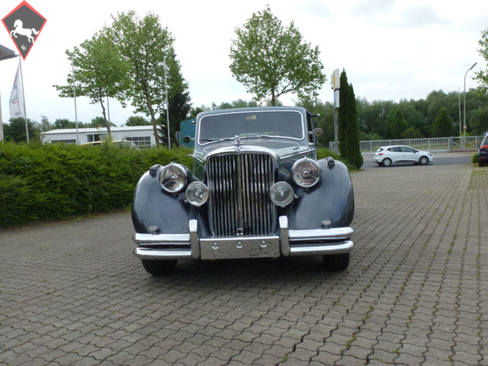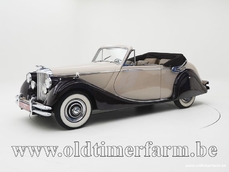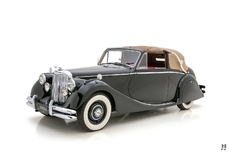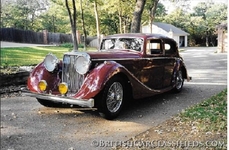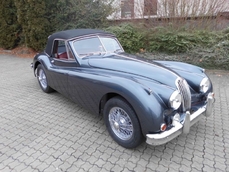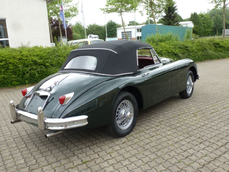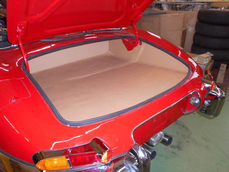Jaguar MkV 5 DHC 1950
General description :
Am Scheideweg zwischen den erfolgreichen Vorkriegs- Modellen der Fa. Jaguar - SS nach dem Krieg entstand
dieses erste Ganzstahlfahrzeug der Firma.. Mit der Entwicklung einer neuen Einzelradaufhängung für die Vorderachse wollte Sir Lyons unbedingt eine Limousine als Nachfolger für die erfolgreichen `MK 4` Modelle, die auf der Vorkriegsplatform gebaut wurden, präsentieren.
So kam es, das diese Ganzstahlentwicklung zwischen Vorkriegsdesign und Moderne ab 1949 bis Ende 1950
noch mit dem unverwüstlichen 3,5l ( Vorkriegs-) Reihenmotor mit ca.125 PS aber mit dem neu entwickelten Fahrwerk auf neuem Chassis sich in den Verkaufsräumen der hauptsächlich amerikanischen Händler zeigte.
Daneben stand, auf verkürztem Chassis mit einer eindrucksvollen Karosserie und dem neuen Motor mit zwei Nockenwellen, der XK 12o.......
Das Vorzeug ist ein wunderbares Reisefahrzeug...ideal auf langen Strecken, dabei geräumig und bequem.
Es bekam die Bezeichnung MK5......und wurde Anfang 1951 mit dem Modell MK7 entgültig ein modernes Nachkriegsfahrzeug...einen MK6 hat es nie gegeben, da das als MK6 bezeichnete Modell des Konkurrenten Bentley mehr als doppelt so teuer, nicht so leicht zu fahren und qualitativ (Rost!) schlechter war.
Das jetzt angebotene Fahrzeug wurde erst im Juni 2017 im Rahmen einer Vollrestaurierung fertig gestellt.
Farblich ausgeführt in attraktiven Zwei-Ton Grau mit grauer Lederausstattung wurde vom Fahrwerk, Motor, Elektrik, Innenausstattung bis zur letzten Schraube zerlegt und neu aufgebaut.
Die Bremsen wurden verbessert, das Getriebe gegen ein 5-Gang Getriebe von Jaguar getauscht.
Auch die Autoelektrik wurde den modernen Erfordernissen angepasst.
Zur Geschichte: Im Juni 1950 wurde der Wagen in den USA zugelassen...die weiteren Wege lassen sich nicht verfolgen. Irgendwann wurde der Wagen nach Australien (!) verkauft, er sollte restauriert werden. Aus Zeitgründen wurde daraus nichts und es erfolgte ein Verkauf nach Deutschland, wo dann die Restaurierung sorgfältig durchgeführt wurde.Natürlich kann das Fahrzeug mit bleifreiem Kraftstoff gefahren werden
Das Fahrzeug besticht durch seine klassische Linien seiner tollen Inneausstattung mit Wurzelfurnier.
Wo immer Sie mit dem Wagen sind....Sie stehen im Mittelpunkt des Interesses..
1950 Jaguar MkV 5 DHC is listed for sale on ClassicDigest in Prinzenstrasse 20ADE-37073 Göttingen by OMTS GmbH for Not priced.
Car Facts
Car type : Car Make : Jaguar Model : MkV Model Version : 5 DHC Engine size : 3.5 Model Year : 1950 Sub type : Convertible Location : Prinzenstrasse 20ADE-37073 Göttingen Vehicle Registration : Undefined
Not priced
People who viewed this Jaguar MkV also viewed similar Jaguar listed at ClassicDigest
Other cars listed for sale by this dealer
About Jaguar
Ah, the story of Jaguar, from its early days as the SS Cars Ltd. to its pinnacle with the D-type, and the street-going evolution in the form of the iconic E-type. There's something quintessentially British about this tale, and I'll narrate it as a British journalist might.In the Beginnings:
Our journey into the world of Jaguar begins in the 1930s, when a company known as SS Cars Ltd. emerged. Despite the unfortunate coincidence of their initials with the rising political tensions in Europe, they started producing stylish and performance-oriented cars. The SS 100, introduced in 1936, was a symbol of elegance and speed, setting the stage for what would become Jaguar.
The Birth of Jaguar:
As the shadows of World War II loomed, SS Cars Ltd. wisely decided to disassociate themselves from the SS initials. Thus, in 1945, they officially became Jaguar Cars Ltd., a name that would soon be synonymous with British luxury and performance.
The XK Series:
Jaguar's post-war era brought us the XK 120, a true sensation in 1948. With its sleek design and a powerful 3.4-liter inline-six engine, it became the world's fastest production car. The XK 120 was the blueprint for what lay ahead – Jaguars that blended style with speed in a uniquely British fashion.
The D-type Dominance:
Then came the D-type, a true racing legend. Introduced in 1954, it won Le Mans three times in the 1950s, showcasing Jaguar's engineering prowess. With its innovative monocoque construction and the iconic fin at the back, the D-type was the apex of Jaguar's motorsport success.
The E-type Emergence:
But the true turning point arrived in 1961 with the introduction of the E-type, often described by Enzo Ferrari as "the most beautiful car ever made." Its long bonnet, curvaceous body, and a 3.8-liter engine delivering exhilarating performance made it an instant classic. The E-type was not just a car; it was a work of art on wheels, and it could hit 150 mph on the road.
Street and Racing Success:
The E-type's beauty was matched by its capability on the track. The lightweight E-types were particularly successful in various racing events, cementing Jaguar's reputation as a force to be reckoned with in motorsport.
The Age of Refinement:
As we delve deeper into the Jaguar story, we find that the 1950s and 1960s were an age of refinement and expansion. Alongside the magnificent D-type and the E-type's iconic emergence, Jaguar introduced models that further solidified its reputation for luxury and performance.
The MK2:
In the late 1950s, Jaguar unveiled the MK2, a sports sedan that combined elegance with power. This sleek four-door saloon was a favorite of bank robbers and law enforcement alike, thanks to its exceptional speed and handling. The MK2 was a symbol of Jaguar's ability to blend sophistication with performance and had a successful racing career as well.
The XJ6:
Fast forward to 1968, and Jaguar launched a car that would define luxury saloons for decades to come – the XJ6. It was a masterpiece of engineering and design, featuring a smooth inline-six engine, independent rear suspension, and a spacious, beautifully appointed interior. The XJ6 was a symbol of British elegance and provided a ride so smooth that it seemed to glide over the road. It became the flagship model for Jaguar and set the standard for luxury saloons, showcasing a level of refinement that left competitors in awe.
The Blend of Classic and Modern:
While the MK2 and XJ6 represented the evolution of Jaguar's saloon cars, they maintained the brand's commitment to performance and luxury. These cars didn't just belong on the racetrack; they were equally at home cruising down the grand boulevards or gliding through the English countryside.
The Challenges of Change:
However, as the 1970s arrived, Jaguar, like many British automakers, faced financial challenges and changes in ownership. The British Leyland era brought both opportunities and struggles, as the brand navigated through various mergers and transitions.
Nevertheless, the legacy of the MK2 and XJ6, along with the D-type and E-type, continues to define Jaguar as a manufacturer that combines timeless elegance with a spirit of performance. These classic models, whether driven on winding roads or parked as collectors' treasures, serve as a testament to Jaguar's enduring presence in the world of automotive excellence.
The Jaguar story, from its early days as SS Cars Ltd. to the creation of automotive icons like the E-type, MK2, and XJ6, is a journey that reflects the very essence of British motoring – a blend of luxury, power, and style that continues to captivate enthusiasts and connoisseurs alike.
